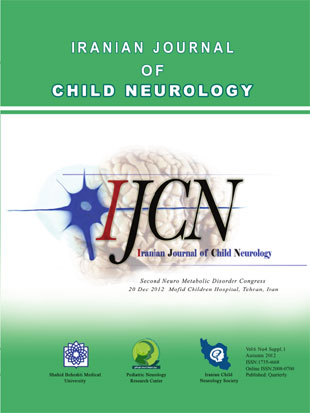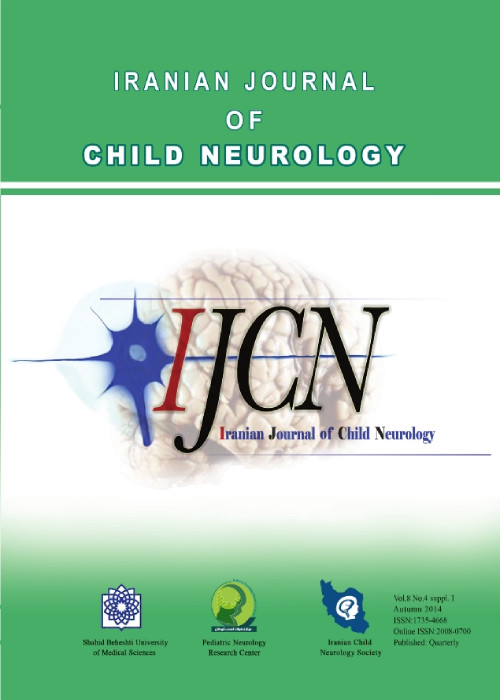فهرست مطالب

Iranian Journal of Child Neurology (IJCN)
Volume:6 Issue: 3, Summer 2012
- تاریخ انتشار: 1391/07/17
- تعداد عناوین: 8
-
-
Page 1Hypertension is called the silent killer and vital organs such as the brain, eyes,kidneys and the heart are the targets. Seizure, central nervous system (CNS)hemorrhage, and cerebrovascular accident (CVA), blindness and heart attacksare the end points.The prevalence of hypertension in children is much less than adults, but evidencereveals that the source of hypertension in adulthood goes back to childhood. In70-80% of cases hypertension is due to renal diseases. In children, hypertensiveencephalopathy (HE) may be the first manifestation of renal diseases. Seizure isone of the most common manifestations of HE.In this article, definitions, etiology, pathophysiology and finally the acute andchronic managements of HE will be discussed.Keywords: Hypertensive encephalopathy, Children
-
Page 9ObjectiveHyperglycemia may occur in the patients affected by any kind of critical illness.This complication makes an adverse effect on the clinical outcome of thesepatients by causing polyneuropathy and myopathy. It has been recently shownthat treatment of hyperglycemia with insulin administration significantly reducesthe prevalence of critical illness polyneuropathy and myopathy (CIPNM) andon the other hand reduces the demand for long-term mechanical ventilation inthe patients admitted to the ICU for more than 1 week. The aim of this studywas to determine the therapeutic effect of insulin in reducing the incidence ofCIPNM in the pediatric intensive care unit (PICU).Materials and MethodsIn this study, we recruited 30 patients admitted to the PICU of Tabriz PediatricHospital. The incidence of CIPNM following hyperglycemia was evaluated inthese patients. The patients were categorized into two groups. In the case group,blood sugar was controlled in the range of 140-180mg/dl by administration of0.05 unit per kilogram body weight of insulin as drip protocol in an hour and inthe control group, placebo was used. Consequently, the incidence of CIPNM,duration of PICU and duration of mechanical ventilation were comparedbetween the two groups.ResultsThe incidence of CIPNM and duration of PICU stay and mechanical ventilationwere significantly reduced in the patients treated with insulin compared to thecontrol group.ConclusionThis study shows that blood sugar control decreases the incidence of CIPNM.Keywords: cal illness polyneuropathy, myopathy, Insulin
-
Page 15ObjectiveSerial seizures occur commonly in inpatient epileptic children. This type ofseizure due to its characteristics has a significant impact on the patient’s health.Untreated serial seizures lead to status epilepticus; therefore, finding a moreeffective treatment for such patients is essential. This study was performed tocompare the outcome of intermittent intravenous diazepam in the pediatricneurology clinic and intravenous midazolam in the pediatric intensive care unit(PICU), in order to introduce an alternative treatment for serail seizures.Materials and MethodsIn this study, 38 inpatient children aged 6 mo-15 years with refractory serialseizures were treated by first line antiepileptic drugs and then randomlytreated with either intermittent intravenous diazepam in the neurology ward orintravenous midazolam in PICU.ResultsFourteen (70%) diazepam group patients and 13 (72.2%) midazolam grouppatients had good response to treatment, there was no significant differencebetween the two groups. Four midazolam group patients and two diazepamgroup patients needed mechanical ventilation and were intubated duringtreatment, with no significant difference between the two groups. Durationsof mechanical ventilation and PICU and hospital stay were not significantlydifferent between the two groups.ConclusionIntermittent intravenous diazepam is an effective alternative therapy formidazolam drip in the treatment of serial seizures due to similar therapeuticeffects and fewer side effects.Keywords: Seizures, Refractory, Children, Midazolam, Diazepam
-
Page 21ObjectiveMigraine is a disabling illness that causes absence from school andaffects the quality of life. It has been stated that headache may representan epileptic event. EEG abnormality is a prominent finding in childrenwith migraine. The aim of this study was to evaluate EEG abnormalitiesin children with migraine.Materials and MethodsTwo-hundred twenty-eight children were enrolled into the study.Evaluation and following of cases was performed by one physician,paraclinical tests were used to increase the accuracy. The study wasconducted under the supervision of pediatric neurology masters and theselected cases were from different parts of the country.ResultsComparing EEG abnormalities in different types of migraine revealedthat there is an association between them. There was also a significant difference between EEG abnormalities in different types of aura. Migrainetype was associated with the patient’s age. Sleep disorders were morecommon in patients with a positive family history of seizure.ConclusionOur study dosclosed migraine as a common problem in children withabnormalities present in approximately 20% of the patients. Migraineand abnormal EEG findings are significantly associated.Keywords: Migraine, Children, Headache, Abnormal EEG, Epilepsy, Relationship
-
Page 25ObjectiveMigraine is a disabling illness that causes absence from school andaffects the quality of life. It has been stated that headache may representan epileptic event. EEG abnormality is a prominent finding in childrenwith migraine. The aim of this study was to evaluate EEG abnormalitiesin children with migraine.Materials and MethodsTwo-hundred twenty-eight children were enrolled into the study.Evaluation and following of cases was performed by one physician,paraclinical tests were used to increase the accuracy. The study wasconducted under the supervision of pediatric neurology masters and theselected cases were from different parts of the country.ResultsComparing EEG abnormalities in different types of migraine revealedthat there is an association between them. There was also a significantdifference between EEG abnormalities in different types of aura. Migrainetype was associated with the patient’s age. Sleep disorders were morecommon in patients with a positive family history of seizure.ConclusionOur study dosclosed migraine as a common problem in children withabnormalities present in approximately 20% of the patients. Migraineand abnormal EEG findings are significantly associated.
-
Page 33ObjectiveThe advent of computed tomography (CT) scan revolutionized the diagnosticevaluation of neurologic patients. The aim of this study was to evaluate brain CTresults of epileptic children.Materials and MethodsIn a descriptive cross-sectional study, noncontrast brain CT scan of 150 consecutive1-18 year old epileptic children whom were referred to pediatric neurology clinic ofShahid Sadoughi University of Medical Sciences, from May 2008 to October 2010 inYazd-Iran, evaluated.ResultsSixty two girls and 88 boys with mean age of 6.6 ± 4.3 years were evaluated.In 38 (25.3 %) children, seizure onset age was under one year and 38 others hadabnormal mental / developmental status. Fifty three children (35.3 %) and 97 (64.7%)had partial and generalized seizures, respectively. Partial seizures were more prevalentin children with seizure onset in < 1 year [41.5% (22/53) vs. 16.5% (16/97)] Result of CT was normal in 74 % (n=111). Among the patients with abnormalresults, 18(46%) had brain atrophy, 10 (25.6%) structural CNS dysgenesia, six (15.4%)intracranial calcification, three (7.8%) hydrocephaly and two had (5.2%) brain tumor.Abnormal brain CT was more prevalent in patients with seizure onset in less than oneyear of age [60.5% (23 of 38) vs. 14.3% (16 of 112), p = 0.003], partial epilepsy [51% (27of 53) vs. 12% (12/97)], and abnormal developmental status [81.5% (31 of 38) vs.7% (8of 112]. Mean age of seizure onset in epileptic children with abnormal brain CT scanwas less (M ± SD:1/17 ± 0.6 years versus 4.02±1.9 years).ConclusionBrain CT scan might be considered in evaluation of epileptic children with partialseizures, seizure onset in less than one year of age or neurodevelopmental delay.Keywords: Epilepsy, Brain CT scan, Children, Neuroimaging
-
Page 39Oculodentodigitalis dysplasia (ODDD) is an extremely rare inherited disorderinvolving the development of the face, eyes, teeth and limbs. In addition,some patients develop neurological problems mostly a spastic paraparesisassociated with white matter abnormalities on magnetic resonance imaging.This report describes a patient with epilepsy, a rare neurologic manifestationof this syndrome.Keywords: Oculodentodigitalis dysplasia, Epilepsy, Spasticity
-
Page 45Congenital insensitivity to pain and anhidrosis (CIPA) or hereditary sensoryautonomic neuropathies type IV (HSAN type IV) is an extremely rare autosomalrecessive disorder initially described by Swanson in 1963.We report a 2.5-year-old boy with clinical features of CIPA as the first case in Iran.The symptoms included recurrent episodes of hyperthermia and unexplainedfever that began in early infancy, anhidrosis (inability to sweat), profound lossof pain sensitivity, neurodevelopmental delay, unconscious self-mutilation offingers, lips and tongue, corneal lacerations, palmar hyperkeratosis, non-painfulfracture and joint deformities in the right ankle. Tearing, deep tendon reflexesand motor and sensory nerve action potentials were normal.Prenatal screening is the sole accessible option to prevent the birth of anaffected child as no cure is available. Early recognition of CIPA patients and itsorthopedic complications, prevention of accidental injuries, regular visual andeye follow-up and specific dental management could be useful in the reductionof frequency and severity of complications.Keywords: HSAN type IV, Congenital insensitivity to pain, Anhidrosis


